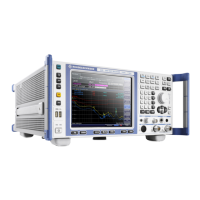Spectrum Measurements
R&S
®
ESR
225User Manual 1175.7068.02 ─ 12
Remote command:
CALCulate<n>:MARKer<m>:FUNCtion:MDEPth[:STATe] on page 785
CALCulate<n>:MARKer<m>:FUNCtion:MDEPth:RESult? on page 784
Harmonic Distortion
Opens a submenu to determine the settings for harmonics measurement and activates
the harmonic distortion measurement.
For details see Chapter 6.1.1.13, "Measuring Harmonic Distortion", on page 337.
Remote command:
CALCulate<n>:MARKer<m>:FUNCtion:HARMonics[:STATe] on page 789
CALCulate<n>:MARKer<m>:FUNCtion:HARMonics:DISTortion? on page 787
CALCulate<n>:MARKer<m>:FUNCtion:HARMonics:LIST? on page 787
All Functions Off
Switches off all power measurement functions.
6.1.1.2 Measuring Channel Power and Adjacent-Channel Power
Measuring the power in channels adjacent to the carrier or transmission channel is
useful to detect interference. The results are displayed as a bar chart for the individual
channels.
● About Channel Power Measurements.................................................................. 225
● Channel Power Measurement Results..................................................................229
● Configuring and Performing Channel Power Measurements................................231
● Softkeys for Channel and Adjacent-Channel Power Measurements.................... 235
● Predefined CP/ACLR Standards...........................................................................246
● Optimized Settings for CP/ACLR Test Parameters...............................................247
About Channel Power Measurements
Measuring channel power and adjacent channel power is one of the most important
tasks in the field of digital transmission for a signal analyzer with the necessary test
routines. While, theoretically, channel power could be measured at highest accuracy
with a power meter, its low selectivity means that it is not suitable for measuring adja-
cent channel power as an absolute value or relative to the transmit channel power. The
power in the adjacent channels can only be measured with a selective power meter.
A signal analyzer cannot be classified as a true power meter, because it displays the IF
envelope voltage. However, it is calibrated such as to correctly display the power of a
pure sine wave signal irrespective of the selected detector. This calibration cannot be
applied for non-sinusoidal signals. Assuming that the digitally modulated signal has a
Gaussian amplitude distribution, the signal power within the selected resolution band-
width can be obtained using correction factors. These correction factors are normally
used by the signal analyzer's internal power measurement routines in order to deter-
mine the signal power from IF envelope measurements. These factors apply if and only
if the assumption of a Gaussian amplitude distribution is correct.
Apart from this common method, the R&S ESR also has a true power detector, i.e. an
RMS detector. It correctly displays the power of the test signal within the selected reso-
Measurements

